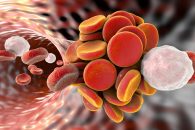The proportion of patients treated with coronary angioplasty who are at a high risk for bleeding is increasing. In this population, extended dual antithrombotic therapy increases the risk of bleeding. The 1-year randomized Onyx one study has demonstrated the non-inferiority of zotarolimus-eluting stents (ZES) vs. biolimus-coated polymer-free stent BioFreedom (DCS). Patients received dual-antiplatelet therapy (DAPT)…
Prophylactic Rivaroxaban Therapy for Left Ventricular Thrombus after ST-Segment Elevation Acute Coronary Syndrome
The incidence of left ventricular thrombosis (LVT) after anterior ST-segment elevation myocardial infarction (STEMI) ranges from 4% to 26%. This is associated with bad long-term evolution. In the past, triple-scheme therapy (vitamin K antagonist plus dual antiplatelet therapy) was recommended to prevent LVT, despite the lack of high-quality scientific evidence and an increase in the…
Should Aspirin Be the Standard of Secondary Prevention of MACE?
Much has been published recently on short term dual antiplatelet therapy (DAPT) both in acute (ACS) and chronic coronary syndrome (CCS) as well as safety of P2Y12 inhibitor monotherapy. When discussing secondary prevention in patients with established coronary artery disease, aspirin (ASA) has been the preferred drug for the prevention of new atherothrombotic events. This…
WOEST 2 | Dual Versus Triple Antithrombotic Scheme in the Real World.
The WOEST study found a significant reduction in bleeding complications post PCI with oral anticoagulation indication (OAC) when treating patients with dual antiplatelet therapy (DAPT) vs. the triple antithrombotic scheme. Several randomized studies have shown these results. At present, the guidelines recommend using the triple antithrombotic scheme in patients according to ischemic and bleeding risk. …
Ticagrelor Shows Benefits in Coronary Microvascular Function after NSTEMI
Coronary microvascular disfunction (CMD) is an important long-term prognosis predictor. CMD treatment can be an effective therapeutic strategy for patients with acute coronary syndrome (ACS). Nevertheless, more studies are needed to assess different strategies. In the PLATO (Study of Platelet Inhibition and Patient Outcomes) study, ticagrelor vs. clopidogrel reduced ischemic events and overall mortality in…
RESTORE | Using Rivaroxaban to Prevent Radial Artery Occlusion After an Intervention
Radial access has long demonstrated its benefit, but one of its most feared complications is radial artery occlusion (RAO), which can vary from 1% to 5% according to different series. There is currently no significant information on post-procedural anticoagulation and the presence of RAO at follow-up. The aim of the randomized RESTORE study was to…
ACC 2022 | ADAPT-TAVR: Endoxaban Is Not Superior to DAPT After TAVR
DAPT-TAVR is a randomized trial that tested endoxaban in patients with no indication for anticoagulation who underwent successful transcatheter aortic valve replacement (TAVR) for symptomatic severe aortic stenosis. This study included 229 patients whose mean age was 80 years; 42% of them were male. Patients were randomized to either endoxaban 60 mg or 30 mg every 24 h or…
ACC 2022 | BENTRACIMAB
This study was presented in phase 2, in a healthy population between 50 and 80 years of age, and it showed the use of Bentracimab reverts the antiplatelet effect of ticagrelor. The study included 205 adults mean age 61, 49% women, previously treated with aspirin and ticagrelor for 48 hrs. who were randomized 3:1 to…
ACC 2022 | PACMAN AMI
Atherosclerosis plaque causing AMI is often large in volume, high in lipids and have a thin fibrous cap. Statins often reduce atherosclerosis progress, but the impact of PCSK 9 inhibitors (alirocumab) after acute coronary syndrome is scarcely known. The aim of this study was to determine the effect of alirocumab using intracoronary imaging (IVUS, OCT,…
ACC 2022 – EDIT-CMD
Roughly 40% of patients receiving a coronary angiography for stable angina (angina episodes twice a week despite medical treatment, lasting 3 months) do not present obstructive coronary artery disease (ANOCA). Between 60 to 90% is due to coronary vasomotor dysfunction (CVDys) which might be interpreted as vessel spasm or microvascular dysfunction. A recent publication from…
ACC 2022 | VALOR-HCM: Mavacamten in Adults with Symptomatic Obstructive HCM Eligible for Septal Reduction Therapy
Roughly 50% of hypertrophic cardiomyopathies (HCM) are obstructive, and of this percentage, most of symptoms can be attributed to this condition. Historically, it has been treated with non-specific drugs such as betablockers or calcium blockers. There is an alternative treatment, septal reduction therapy (SRT), done either by surgery myectomy and alcohol septal ablation, both normally done in…





